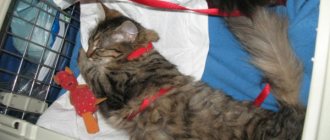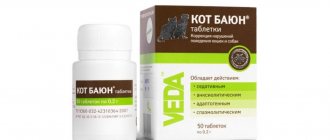Covertal is used to treat cats, dogs and other animals with liver diseases.
This is a homeopathic medicine consisting of natural ingredients. Covertal exists in the form of an injection solution in 2 ampoule volumes: 10 ml and 100 ml. The drug is not available in tablets. Each package consists of 5 glass ampoules.
Attention! The solution in ampoules is transparent and colorless, without sediment or odor.
Buy Covertal for cats =>>
Description of the drug Covertal for cats
Covertal is a homeopathic medicine that is used in veterinary medicine to treat liver diseases. The developer of the drug formula is, and the official representative of the brand is Helvet LLC (Moscow region, Dolgoprudny).
The group was founded in 1995 as a manufacturer of homeopathic medicines, and the company's first product was the drug Liarsin. In 2005, a subsidiary organization, AlexAnn, was separated from the group of companies. This company was supposed to develop new formulas and produce medicines ordered by Helvet. The first independent recipe of a separate organization was Fospasim, and by 2010 the production volume reached more than 1 million bottles per year. In 2011, the manufacturer of homeopathic products began to work in accordance with GMP requirements. Now the catalog of AlexAnn LLC includes drugs for the treatment and prevention of many diseases to which cats are susceptible.
AlexAnn LLC and Helvet are leaders in the production of homeopathic remedies in Russia
Covertal release form
Covertal is available in the form of an injection solution. The drug is bottled in ampoules or bottles made of transparent glass. The volume of ampoules is 2 or 5 cm3, bottles are 10 or 100 ml. The bottles are sealed with rubber stoppers and rolled in metal rings with notches on them. Large bottles are sold individually, and small bottles are sold in packaged form (the outer packaging is a cardboard box). Labels of bottles and boxes contain information about the manufacturer, expiration dates, purpose, active ingredients, etc. Ampoules are sold in packs of 5 pieces. The outer packaging can be a cardboard box or a transparent plastic tray. The pack also contains a special miniature knife for opening ampoules and an annotation.
Covertal can be found in a package with a green stripe or with a green image (5 animals). It depends on which organization produced a particular batch (“Helvet” or “AlexAnn”). Both packaging options are considered valid. The main thing is to make sure that you are offered a drug with a good shelf life. The least amount of information is indicated on the ampoules, but even they are marked with the date and series of issue.
At the veterinary pharmacy I was told that “Helvetic” drugs are difficult to distinguish from fakes only by the color and pattern on the pack. Cat owners need to pay attention to the bottles themselves. The original bottles always have only green caps, and the notches are always cut in the shape of semicircles. A counterfeit solution may have a silver cap and a dotted notch.
In addition to the image on the Covertal packaging, the color of the packaging may also differ - from light green to dark green
Table: composition of the drug
| Component name | Contents in 1 l |
| Active components | |
| Chelidonium majus (greater celandine) | 200 ml |
| Lycopodium clavatum (club moss) | 150 ml |
| Veronica officinale (Veronica officinale) | 150 ml |
| Carduus marianus (milk thistle) | 150 ml |
| Citrullus colocynthis (colocynth, "bitter gourd") | 150 ml |
| Taraxacum officinale (dandelion) | 200 ml |
| Auxiliary components | |
| Methyl parahydroxybenzoate | 0.5 g |
| Sodium chloride | 5.8 g |
| Sodium acetate trihydrate | 2.0 g |
| Hydrochloric acid | Up to pH 5.4 |
| Ethyl alcohol 95% | 5.26 g |
| Water for injections | Up to 1000 ml |
Pharmacological properties
A distinctive feature of homeopathic remedies is their natural composition. This determines the pharmacological action of Covertal. This hepatoprotector consists of extracts and extracts of medicinal plants:
- Celandine, a member of the poppy family, is similar to opium plants. Celandine juice can affect the central part of the liver, kidneys, pancreas and even the spleen.
- The substances contained in milk thistle can neutralize toxins accumulated in the liver. It is believed that the juice of spotted milk thistle can even neutralize the poison of the toadstool.
- Colocynth is a powerful analgesic that is used in the homeopathic treatment of non-inflammatory diseases. In Kovertal it is used to relieve areas of neurological pain and spasms.
- Moss has a mild blood-stimulating effect and is able to influence the nervous system. Homeopaths use tincture of moss spores in the treatment of serious liver pathologies (including cirrhosis).
- The herb Veronica officinalis has an anti-inflammatory and immunostimulating effect on the cat's body.
- Dandelion eliminates bile stagnation, improves its outflow, increases its secretion, and reduces viscosity.
Covertal contains substances that have a beneficial effect on the condition of the liver
approximate cost
Covertal, like any homeopathic remedy, is over-the-counter. The drug can be purchased at a pet store, veterinary pharmacy on duty, or a point of sale of pet products. The cost of the drug depends on the volume:
- 10 ml - from 250 to 300 rubles;
- 100 ml - up to 1200 rubles.
In addition, Covertal can be ordered in the online store. Sometimes this method of purchasing turns out to be the most profitable, but the disadvantage in this case is the wait for the order.
Storage conditions and periods
Storage conditions for Covertal hepatoprotector are specified in the manufacturer's instructions:
- the injection solution should be stored in the manufacturer's sealed packaging, separate from food and feed, in a dry place, protected from light and out of the reach of children;
- storage temperature - from 0 °C to 25 °C;
- the drug in bottles with damaged integrity, if there is turbidity or change in color, foreign impurities, if the expiration date has expired or storage conditions have been violated, is unsuitable for use.
If you store the solution in compliance with all requirements, it will be suitable for 3 years. The shelf life should be counted from the production date indicated on the packaging.
When I have to throw away a box of a drug, I label the bottle/vial/ampoule itself (even if there is already a paper label on the container). There have been many cases where the label has become wet, faded in the sun, or simply become unreadable. You can put a sticker with the name of the medicine and expiration date (or a simple piece of paper). I usually make inscriptions with a permanent marker (it does not erase, sometimes even after getting wet). It is good to store drug annotations in a separate folder. I have a special notebook for this.
Covertal is best stored in a medicine cabinet, along with other veterinary medications.
Storage rules
In order for the medicine to be stored for as long as it is written on the manufacturer’s packaging, it is important to adhere to the following recommendations:
- The optimal storage temperature is from 0 to +25 degrees Celsius.
- It is important to store bottles of solution in the manufacturer’s box, and also away from cat food and food.
- If you notice that the solution has become cloudy or a precipitate has formed in it, it should be thrown away. Such signs indicate that storage conditions have been violated. The spoiled solution must be disposed of immediately, as it is not suitable for treatment.
- Store the coverlet in a dark place, as direct exposure to sunlight will shorten its shelf life.
Indications for use in cats
Covertal as part of complex therapy is prescribed to cats with the following pathologies:
- acute and chronic hepatitis;
- hepatosis (inflammatory liver diseases);
- fatty liver degeneration (eg in cats with diabetes);
- toxic lesions (hepatotoxicosis);
- infectious diseases;
- invasive diseases (caused by parasites).
Some cat owners also use homeopathic medicines to prevent various diseases. However, it should be understood that self-medication is a huge risk. Therefore, before you start injecting your cat with Covertal, consult your veterinarian.
Composition and action
The active ingredients of the homeopathic medicine are:
| Celandine (chelidonium) | A medicinal plant that has long been known in medicine, and Paracelsus also used an infusion of celandine as an analgesic for colic, bile fever and liver diseases; club moss (lycopodium) - spores or herbs have anti-inflammatory, antispasmodic, analgesic effects, in folk medicine and homeopathy they are used as part of medicines for liver diseases, colic, spasms; |
| Thistle | Or milk thistle is used for liver disorders, hepatic congestion, jaundice due to infectious hepatitis and other diseases; Colocynth is a plant of the watermelon genus with fruits resembling a pumpkin. The plant is poisonous, but in homeopathic doses it can benefit the body. Has anti-inflammatory, antispasmodic effects; |
| Colocynthus | A plant of the watermelon genus with fruits resembling a pumpkin. The plant is poisonous, but in homeopathic doses it can benefit the body. Has anti-inflammatory, antispasmodic effects; |
| Taraxacum | Common dandelion, which is used in homeopathy as part of preparations for the treatment of the liver and gallbladder; |
| Veronica officinalis | A plant that is used in folk medicine and homeopathy as an anti-inflammatory agent for kidney inflammation and liver diseases. |
Veterinarians recommend Covertal for the treatment of pets suffering from chronic liver diseases and acute inflammatory processes. The drug helps normalize the functioning of liver tissue.
How to use Covertal
If indicated, Covertal should be administered to cats intramuscularly or subcutaneously. These injections can be done independently at home. Intramuscular injections lead to faster results, but for an inexperienced cat owner, the option of a subcutaneous injection (in the withers) is more suitable.
The cat owner can give his pet subcutaneous injections himself.
I always give all the injections to cats myself, but my sister does not have such skills. When Donut (sister’s cat) got sick, he was prescribed medications that needed to be injected just into the withers. I didn’t have the opportunity to visit her, so we called via video conference. She was able to get the first injection despite all her fears. The most difficult thing in this matter was fixing the cat in the desired position. To keep Donut from twitching, she put a clean sock on his head.
Video: how to give a painless injection to a cat yourself
Cat treatment plan
For chronic liver damage, Covertal should be administered 3 times a week. The course of treatment can last up to 1.5 months (depending on the complexity of the diagnosis). If the cat suffers from an acute form of the disease, then injections should be done daily (1 or 2 times) for 2 weeks. If the symptoms of the disease have not disappeared, the course can be repeated, but the manufacturer does not recommend exceeding the 2-week norm.
In any case, it is not recommended to skip the next injection. After all, homeopathy is a mild-acting medicine, so the effect of their use is most often cumulative. If an injection is missed, the treatment regimen should be continued as usual and with the same dosage.
Table: Covertal dosage
| Cat weight | Single dose |
| From 1.5 to 3 kg | Up to 0.3 ml |
| From 3 to 5 kg | Up to 0.5 ml |
| From 5 to 10 kg | Up to 1 ml |
From personal experience, I know that such dosages are not always convenient. It is not always possible to obtain the required dose with a regular syringe. A more convenient insulin syringe can also be purchased at a human pharmacy. Its scale is smaller and the sleeve is thinner, so it is easier to see the level of the solution in the syringe. In addition, such syringes have a thinner and shorter needle (which means the injection will be less painful).
Small doses of drugs are more convenient to administer with small syringes
Compatibility with other drugs
Covertal can be used together with other drugs. The combination of homeopathic, symptomatic and pathogenetic drugs depends on the specific diagnosis.
Table: combination of Covertal with other medications
| Diagnosis | Approximate combination of Covertal with other drugs |
| Cirrhosis of the liver |
|
| Hepatitis |
|
| Liver failure |
|
Covertal can be combined with almost any drug
Feedback from cat owners about Kovertal
Julia . Last year our cat was poisoned by something. At the dacha.. She constantly felt sick and refused to eat. On the second day, I called the doctor, and he prescribed a course of Covertal for 10 days. She stopped vomiting the next day, but I obediently gave her injections for all 10 days. To be sure...
Anna . When we picked up our cat on the street near the store, the first thing we did was wash her and take her to the vet the next day. Our Krosha looked weak, the doctor advised us to get tested. As a result, they diagnosed toxic hepatitis and prescribed Covertal. After 3-4 days of taking it, Krosha became playful and had an appetite. She and her husband gave her the injections themselves for 2 weeks, then she had another appointment with the veterinarian, tests - everything came back to normal. In general, we were pleased with the result; our cat quickly returned to normal.
Buy Covertal for cats =>>
Special instructions and precautions
Covertal is considered a low-hazard substance in terms of the degree of influence on the cat’s body. There are no special rules for handling this drug. It is recommended to observe general personal hygiene requirements:
- While working with the solution, you should refrain from eating, drinking and smoking.
- If the medicine gets on the skin or mucous membranes, it should be washed off with warm water.
- If you are allergic to one of the components of Covertal, you can use personal protective equipment (mask, gloves).
If after working with Covertal you have signs of an allergic reaction, you should consult a doctor.
Reviews:
Veronica: A month and a half ago, trouble came to our family, because our darling Seraphim began vomiting in the morning. This lasted 2-3 days, and then we realized that this was not just poisoning. The husband said that in any case, Sima should be taken to the clinic. There they conducted an examination, and it turned out that our cat had stage 2 kidney failure. The veterinarian immediately said that 100% treatment for such a pathology simply does not exist. Therefore, he prescribed us 2 drugs, one to maintain immunity, and the second to restore it - Covertal. It turned out that this was a homeopathic medicine; when my husband found out about this, he just laughed. He is skeptical about such drugs. But later he changed his mind, since after a week of treatment our cat’s condition improved significantly. She regained her interest in eating and her vomiting completely disappeared. We will go for examination again soon, but I am sure that with this wonderful remedy, our Sima will definitely recover.
Stepan: After severe poisoning, our Siamese cat Maggie developed liver inflammation. Unfortunately, we did not find out this immediately, but only after 5 days, when we decided to seek help from a veterinarian. I give the injections myself, as there is nothing complicated about it. And judging by external signs, I am sure that Maggie is on the mend. There are no side effects, so I can confidently recommend Covertal to all furry owners!
Contraindications and side effects
Since all components of the solution are natural, there are practically no contraindications to its use. The only limitation is the intolerance of the components . As a rule, there are no side effects from using the solution. If a cat has hypersensitivity to the components of Covertal, then its use should be discontinued (select an analogue that does not contain an allergenic component). In case of a severe allergy to the drug, the cat can be given an antihistamine (after consulting a veterinarian). In some cases, treatment to relieve symptoms may be necessary.
Description and indications
Covertal improves the protective properties of the liver, promotes metabolism in its cells, relieves inflammatory reactions, activates tissue regeneration, normalizes blood circulation, and also increases bile secretion and relieves spasms of the gallbladder.
The veterinary drug Covertal is used to treat:
- hepatitis;
- degenerative processes in the liver;
- intoxication with organ damage;
- complications after parasitosis.
The medicine is also used to prevent liver diseases.
Covertal is a safe, non-toxic product, but it is only allowed to be administered to a pet after examination by a specialist.
Analogues of Covertal according to indications for use
Other hepatoprotectors are analogues of Covertal:
- Lyarsin;
- Hepatojekt;
- Hepatolux;
- Carsil.
Table: characteristics of Kovertal analogues
| Name | Compound | Manufacturer | Contraindications | Side effects | Release form | Price |
| Liarsin |
| "AlexAnn" (Russia) | Component intolerance | Allergic reaction to components |
| From 300 rubles (20 ml) |
| Hepatolux |
| Agrobioprom (Russia) |
|
|
| From 230 rubles (25 ml) |
| Karsil | Active ingredient: milk thistle fruit extract dry (equivalent to silymarin). Kernel excipients:
Shell excipients:
| Sopharma (Bulgaria) |
|
| Tablets for oral use | From 300 rubles (80 pcs) |
| Hepatoject |
| "API-SAN" (Russia) | Component intolerance | Allergy to components | Solution for subcutaneous, intramuscular, intravenous injections | From 600 rubles (100 ml) |
Photo gallery: Kovertal analogues
L-ornithine, L-citrulline and L-arginine are the active ingredients in Hepatoject, which are derivatives of urea
The components contained in Liarsin have a combined effect on the entire gastrointestinal tract of the cat (including improving metabolism and strengthening the immune system). Hepatolux, like most homeopathic medicines, can be combined with any veterinary medicines and feed Karsil is intended for the treatment of cirrhosis liver in humans, but in veterinary medicine it is used quite often
Purpose
Homeopathic medicine is used as an effective drug:
- for hepatitis;
- toxic liver damage;
- degeneration of fatty liver tissue;
- infectious diseases that occur in severe form and are characterized by liver damage;
- infestations
The liver is a vital internal organ that performs important functions in the body: it participates in hematopoiesis, ensures the removal of toxins from the body, the production and storage of fats, carbohydrates and important enzymes involved in the processes of food digestion, metabolic processes and blood purification. Liver diseases can result in disastrous consequences for your pet, with premature death, so it is important to contact a veterinarian at the first symptoms of organ damage.
Liver pathologies can be acute or chronic. Dangerous acute diseases include infectious hepatitis and leptospirosis. When dangerous viruses enter an animal’s body, the liver may be damaged. Hepatitis is a contagious disease manifested by dysfunction of the liver and gastrointestinal tract, fever, and damage to the central nervous system.
Leptospirosis is an infectious disease carried by rodents. The pathology is manifested by refusal of food, increased temperature, and ulceration of the oral cavity. Treatment of acute illness requires the use of strong antibiotics.
Chronic liver pathologies are often the result of anatomical disorders. Diseases can be of a secondary nature; they can be caused by the presence of malignant tumors (not only in the liver, but also in other organs), inflammatory processes in the dog’s body, autoimmune diseases, and pathologies of the bile ducts. Common symptoms of liver disease are:
- refusal to eat or loss of appetite;
- noticeable weight loss;
- lethargy, drowsiness, depression;
- vomit;
- diarrhea;
- increased thirst;
- yellowing of mucous membranes, sclera;
- change in the consistency and color of feces (stool becomes pale).
Older dogs are primarily at risk for chronic liver pathologies, but some breeds, due to anatomical features, have a genetic predisposition to liver diseases. For example, Bedlingtons often suffer from copper toxicosis.
The danger of diseases in which liver function is impaired is that their symptoms do not appear at the stages when the vital organ refuses to work at 80%. The consequences, alas, are sad.
Pancreatitis is a common disease in dogs. This is an inflammation of the pancreas, but it causes dysfunction of the liver, manifested by decreased appetite, shortness of breath, and dehydration - a dangerous symptom that can be fatal.
Important!
The most dangerous liver disease is cirrhosis. Degeneration of organ tissue is possible as a consequence of certain hepatologies and severe intoxications of the body.











